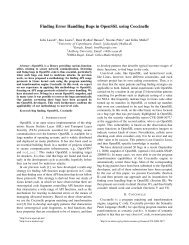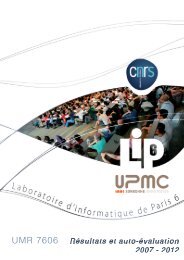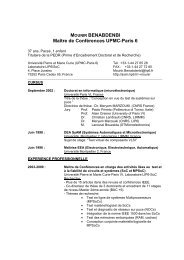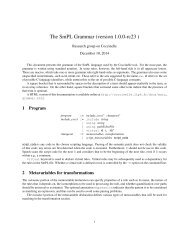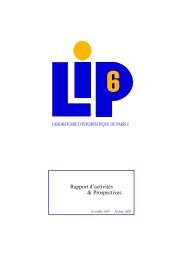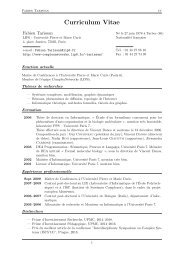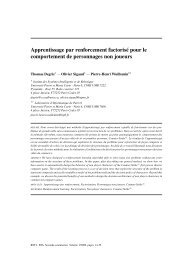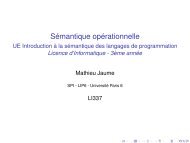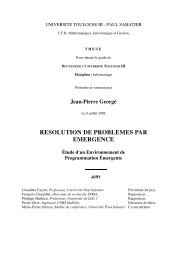Proceedings [PDF] - Measurement and Analysis of P2P Activity ...
Proceedings [PDF] - Measurement and Analysis of P2P Activity ...
Proceedings [PDF] - Measurement and Analysis of P2P Activity ...
Create successful ePaper yourself
Turn your PDF publications into a flip-book with our unique Google optimized e-Paper software.
International Conference Advances in the <strong>Analysis</strong> <strong>of</strong> Online Paedophile <strong>Activity</strong> Paris, France; 2-3 June, 2009<br />
Isis 1 : Protecting Children in Online Social Networks<br />
Awais Rashid, Paul Rayson, Phil Greenwood, James Walkerdine<br />
Computing Department, Lancaster University, UK<br />
{awais | greenwop | paul | walkerdi} @comp.lancs.ac.uk<br />
Penny Duquenoy, Patrick Watson<br />
Middlesex University, UK<br />
P.Duquenoy@mdx.ac.uk, P.Watson@mdx.ac.uk<br />
Margaret Brennan<br />
Child Exploitation <strong>and</strong> Online Protection Centre, UK<br />
maggie.brennan@ceop.gov.uk<br />
Matt Jones<br />
Swansea University, UK<br />
mattjonez@gmail.com<br />
Abstract<br />
The aim <strong>of</strong> the Isis project is to develop an ethics-centred monitoring framework <strong>and</strong> tools for<br />
supporting law enforcement agencies in policing online social networks for the purpose <strong>of</strong><br />
protecting children. The project is developing natural language analysis techniques to help<br />
identify child sex <strong>of</strong>fenders from chat logs <strong>and</strong> monitoring mechanisms that can be noninvasively<br />
attached to file sharing systems for identifying the distributors <strong>of</strong> child abuse<br />
media. The ethical issues associated with such monitoring activities are studied through<br />
consultations with representatives from stakeholder communities <strong>and</strong> fed back into the<br />
development <strong>of</strong> the framework <strong>and</strong> tools. The project results are to be used <strong>and</strong> evaluated by<br />
specialist international law enforcement agencies as part <strong>of</strong> their own policing activities.<br />
1. Introduction <strong>and</strong> Overview<br />
Recent years have seen a rapid rise in the number <strong>and</strong> use <strong>of</strong> online social networks. Such<br />
social networks vary in nature from chat systems, for example, MSN, Skype <strong>and</strong> IRC, to<br />
online communities, such as, MySpace <strong>and</strong> YouTube, through to file sharing systems, for<br />
instance, peer-to-peer networks: Gnutella, BitTorrent, FastTrack, etc. Amongst the many<br />
types <strong>of</strong> ‘risk’ on the internet as mentioned in the Byron review in the UK [1] <strong>and</strong> Internet<br />
Safety Technical Task Force in the US [2], these social networks pose two significant risks in<br />
terms <strong>of</strong> child exploitation. The first major type <strong>of</strong> risk is paedophiles <strong>and</strong> other child sex<br />
<strong>of</strong>fenders predating on children. Children actively participate in social interactions using<br />
forums such as chat rooms <strong>and</strong> web-based communities. Offenders can use such forums to<br />
predate on children, or even to plan the commission <strong>of</strong> sexual <strong>of</strong>fences against children.<br />
These concerns are reflected by the formation <strong>of</strong> the Virtual Global Taskforce <strong>and</strong> specialist<br />
UK enforcement agencies <strong>and</strong> Scottish legislation to criminalise the ‘grooming’ <strong>of</strong> children in<br />
chat rooms in October 2004. The second risk is the <strong>of</strong>fence <strong>of</strong> distributing <strong>and</strong> sharing child<br />
abuse media. Child sex <strong>of</strong>fenders can formulate their own social networks using mechanisms,<br />
such as file-sharing systems, in order to distribute <strong>and</strong> share child abuse media. The scale <strong>of</strong><br />
distribution <strong>of</strong> illegal media (including child abuse media) on such file-sharing systems was<br />
highlighted by a recent study at Lancaster University [3], which found that 1.6% <strong>of</strong> searches<br />
<strong>and</strong> 2.4% <strong>of</strong> responses on the Gnutella peer-to-peer network relate to illegal sexual content.<br />
Given the system’s scale, these results suggest that, on the Gnutella network alone, hundreds<br />
<strong>of</strong> searches for illegal images occur each second. The study also found that, <strong>of</strong> those users<br />
sharing illegal sexual content, 57% were solely devoted to such distribution while half <strong>of</strong> the<br />
material shared by another 17% involved such content.<br />
1 This research is supported by a UK research grant from EPSRC/ESRC (reference<br />
EP/F035438/1) involving the Universities <strong>of</strong> Lancaster, Middlesex <strong>and</strong> Swansea. For further details,<br />
see the project website (http://www.comp.lancs.ac.uk/isis/)<br />
33


![Proceedings [PDF] - Measurement and Analysis of P2P Activity ...](https://img.yumpu.com/32964521/33/500x640/proceedings-pdf-measurement-and-analysis-of-p2p-activity-.jpg)

